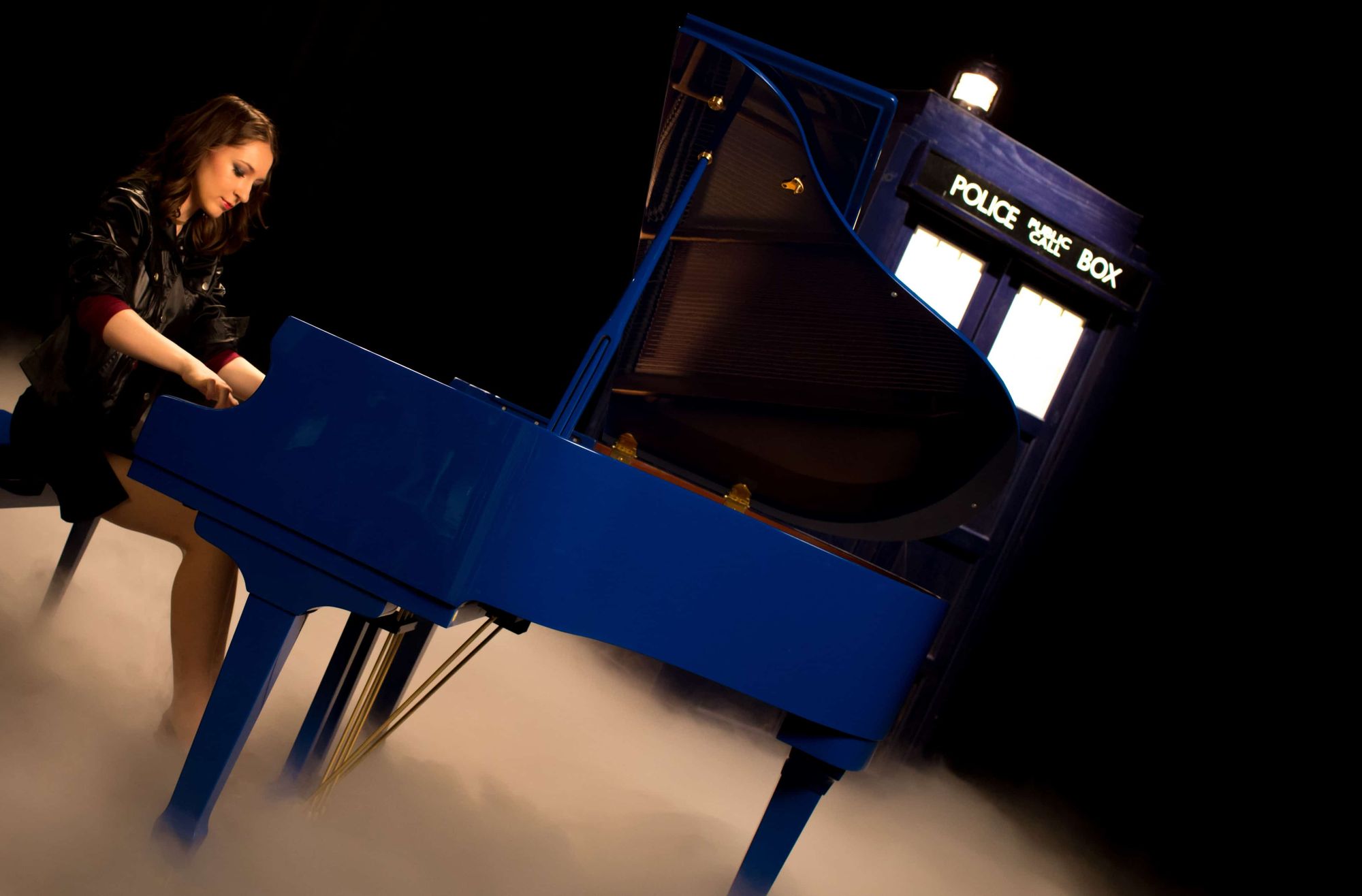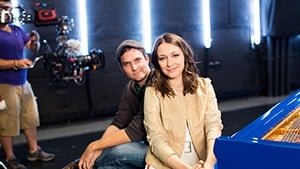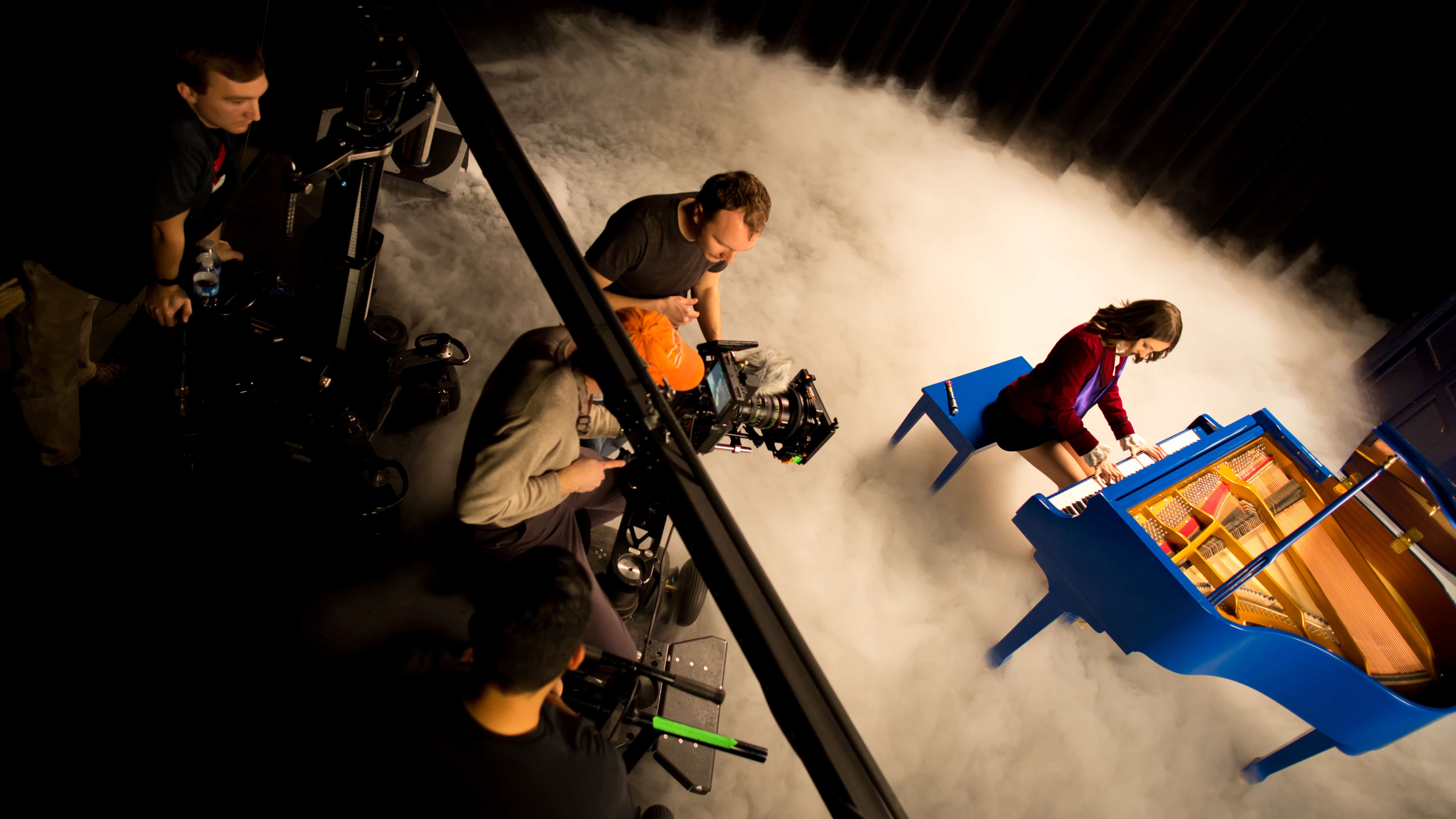Q&A with Performance MVPs (Musical Visual Phenoms) Player Piano
What do you get when you cross a world-renowned concert pianist/composer with an accomplished television and social media director/producer, and then throw in elaborate costumes, embellished pianos and dreamy backdrops for good measure? It’s the dramatically intriguing, musically electrifying Player

What do you get when you cross a world-renowned concert pianist/composer with an accomplished television and social media director/producer, and then throw in elaborate costumes, embellished pianos and dreamy backdrops for good measure? It’s the dramatically intriguing, musically electrifying Player Piano.
Before introducing you to the dynamic duo behind YouTube sensation Player Piano, we’ll let you experience their exciting music and imagery for yourself with their latest “Doctor Who Theme” project, in which virtuosic pianist Sonya Belousova performs her mesmerizing arrangement (available at Musicnotes now) complete with the TARDIS and 12 costume changes.
In addition to “Doctor Who,” director Tom Grey and composer/pianist Sonya Belousova have transformed video game classics, pop music legends and classical mainstays (impromptu dueling Bumblebees, anyone?). We asked the pair behind the piano, which at times metamorphoses into a pinball machine-hybrid, how they got their start, how technology is changing the musical landscape and what future projects they have up their very talented sleeves.

Musicnotes: When and how did the concept of Player Piano come to be?
Tom: I first met Sonya a couple of years ago when I was producing another show for Stan Lee’s YouTube channel. I was auditioning dozens of pianists, and a composer friend of mine tipped me off to this incredibly talented Russian pianist that I should check out. What I didn’t realize at the time was that I didn’t need a pianist… I needed Sonya.
Sonya: Ha! Tom clearly underestimated how much he needed someone who is both a composer and pianist for the job as he was looking for not only a performer, but also a composer to create original arrangements of various themes. The composing aspect is key. My experience as a film composer and a concert pianist allowed us to explore different soundtrack themes and video game scores in a new, unique way.
Tom: So we did a couple of episodes of that show before the channel ultimately ceased producing original content and we were left without a show or funding. At that point Sonya and I had developed a really great friendship and working relationship and we wanted to find a way to continue forward. After pitching it around town, we ultimately decided to go completely independent and start our own channel, and Player Piano was born.
Sonya: The problem was that we didn’t have the funding to really produce the content we wanted, and so we went out and raised a bit of money from friends, produced our first few episodes, and launched an IndieGoGo campaign.
Tom: We also had a great sponsorship from the Anime Expo to produce a video based off of the popular anime Akira, which also included Sonya performing her original arrangement as a featured soloist with a 70-piece orchestra and 40-piece choir at the 2014 Anime Expo. And that’s really how it all began.

How do you select which songs will get the stunning Player Piano transformation?
Sonya: We usually discuss a lot of ideas. Music licensing always plays a big role in this process in order for the content to be legally uploaded to YouTube. Obviously we take into account how we think a video would do and the overall popularity of a certain piece, but not always. We did Duel of the Bumblebees because Tom came up this fantastic idea and we thought it would be a lot of fun, regarding Montagues and Capulets – I’m a huge fan of Prokofiev and Tom absolutely loves this piece, so we just had to do it. So there isn’t a specific criteria behind this process.
Tom: I usually first come to Sonya with songs that I’d like to hear personally. We pick a couple that we both agree on and then I start researching the licenses. But it always starts with what either Sonya or I want to do.
Would you be able to walk us through the process from the moment you select a song for a project, to then composing the music, concepting the production, and ultimately to the video’s release?
Sonya: I’ll talk more about the music production side of this process. Once we settle on a specific music theme or song and the rights have been secured, I then start arranging this theme. This process usually takes from 2 days up to a week depending on the complexity of the arrangement I’m envisioning, as well as how much material the original theme contains in order to be arranged for a different instrument/set of instruments. I never write a note-by-note transcription.
[blockquote source=”Sonya Belousova”]The whole idea behind my arranging process is to give the original music theme a new unique spin that reflects how I feel about that particular music at the moment.[/blockquote]
Simply covering someone else’s work doesn’t particularly appeal to me as a composer; it doesn’t carry any creative idea behind it. The whole idea behind my arranging process is to give the original music theme a new unique spin that reflects how I feel about that particular music at the moment.
While I’m working on the arrangement Tom is usually busy with the video pre-production. Once I have something to show him, he usually stops by to check it out and give me his thoughts. After the arrangement is completed, it takes me a few additional days to learn the music and have it memorized. After that, we go to the Firehouse Recording Studios to do it. They have an amazing 7’4″ Bösendorfer with a deep and rich sound that I absolutely adore. Once the music has been recorded, the session goes straight to my mix engineer. In the meantime, while he’s working on the mix, we shoot the video. After that, I deliver Tom the final mix and start working on a new arrangement.
Tom: When we start to think about what songs we would like to do, I usually begin the process of developing a video idea. Sometimes the video concept will affect Sonya’s writing process. For example, in Akira I really wanted to see a bar populated with Akira-type characters using real life objects to form the backbone of the song’s beat. Sonya brilliantly took that idea and ran with it when arranging the piece.
“Doctor Who” was another example of starting with a video concept. But there’s also songs such as “Bohemian Rhapsody” or “Ghost Waltz,” where Sonya arranged the piece first and then I came up with a video around how the music made me feel. “Ghost Waltz” was based off of a piece called the “Untitled Waltz,” which was the main title for the ‘Stepford Wives,’ but instead of making something ‘Stepford Wives’ related, I really got a spooky vibe from it and envisioned ghosts dancing all around. That’s how that one came about.
(Preview & download the sheet music for Sonya’s rousing arrangements of “Tetris Theme (Korobeiniki),” “Bohemian Rhapsody” and “Ghost Waltz” at Musicnotes.com.)
How do you think YouTube has affected the way in which people experience music?
Sonya: I think YouTube makes the whole music experience much more interactive for the audience, and the fans become more involved. For instance, when we ask what arrangement our fans would like to hear next, we receive lots and lots of comments and discussions in regards to our question. YouTube helps bringing the artist and the audience closer together.
Tom: YouTube has certainly allowed musicians to find a wider audience than most have had available to them in the past. I first wanted to make piano videos because I became addicted to watching other pianist cover film/tv scores. It allowed me to geek out to my favorite scores in a new way, while at the same time inspiring me to take that concept to another level visually.
Similarly, do you have a specific experience in mind as you’re creating these amazing music videos?
Tom: We just want to make fun videos that enhance the music underneath. I really enjoy watching this style of videos, so I’m hoping others do as well. It’s fun to go on set and shoot a beautiful arrangement of “Bohemian Rhapsody” the first half of the day and then find ourselves on a cloud shooting Sonya in 12 different costumes performing “Doctor Who” in the second half of the day. I used to work an office job. This is much better.
We’re thrilled to have the opportunity to share in the “Doctor Who” video release. Would you be able to give us any sneak peeks as to what’s next for Player Piano?
Sonya: We will be releasing my arrangement of the “I Am The Doctor” theme soon. Since we decided to work on two themes from the same show, I wanted to make them completely different from each other, both musically and stylistically. “I Am The Doctor” will have a much darker tone than the original theme and will be much more complex orchestration-wise than just solo piano, so I’m really excited about it.
We’re definitely planning to have more live shows in the future. As I mentioned before, last year we had a fantastic show at the Anime Expo with a 70-piece symphony orchestra. We’re currently in talks to have more shows like this in the near future. Also, I’m currently working on arranging an album of the classic Nintendo themes based off of the themes from our Nintendo On The Spot video.
Tom: We have a video based off of “Happy” made with a band of puppet musicians. That one will be interesting. And for the Nintendo Themes videos, we’re cooking up probably the coolest thing we’ve ever done… but I can’t reveal much about that yet !
[divider type=”thin” spacing=”10″]
A huge ‘Thank You’ to Tom and Sonya of Player Piano for taking the time to share their background story and insights with us. If you haven’t already explored the Player Piano YouTube page, go now! In fact, we suggest watching each video at least twice to take it all in, and subscribe to see their new projects.
And, when you’re done “ooh-ing” and “ahh-ing” over the stunning videos, visit Musicnotes.com to download the sheet music. You, too, can transform your music room into foggy London, a ghostly plot or a rock concert hall.
Do you have a song you’d like to see get the Player Piano treatment? We’d love to hear your suggestions in the comments section below.

